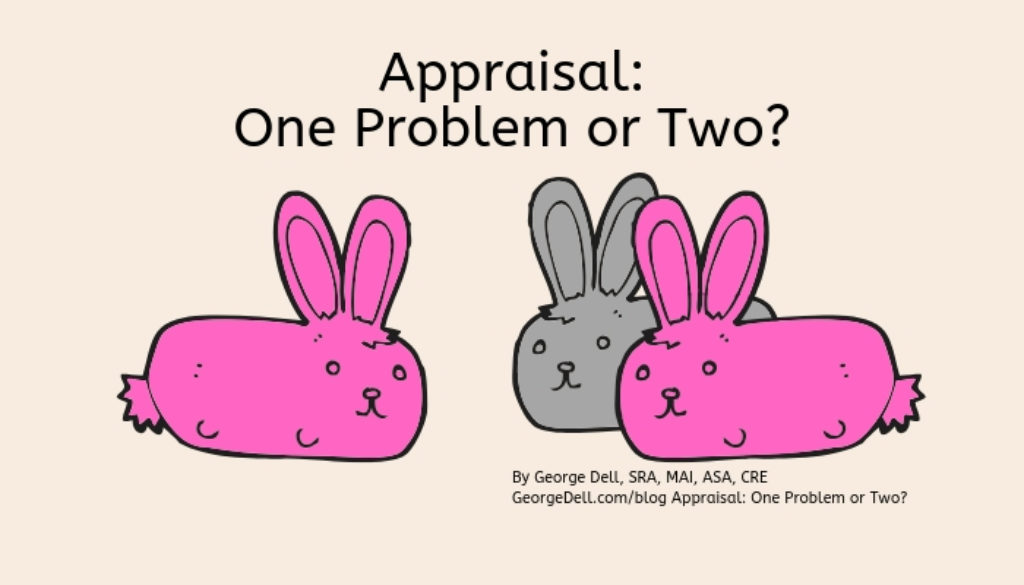We have been taught that appraisal solved one problem: the opinion of value.
We were taught an “appraisal process” (now a “Valuation Process”). The process is called a procedure. It goes like this:[1]
- Identify the problem
- Decide on your scope of work
- Collect the data and describe the property
- Analyze the data (include market analysis)
- Opine on land value
- Apply the 3 approaches to value
- Reconcile why things don’t match
- Report of defined value
This general flow of things worked well when data was sparse, difficult to gather, and spotty. In short: pick some comps, compare some comps, and declare a number . . .
Today, this “process,” this sequence, is troubling. It says decide your scope of work before you have looked at the market, and before you have described the property . . .
Then do an analysis of what market is relevant, after you have picked the data. Hmmm. Then apply three approaches. (How is that different from “analyze the data”)? Then justify why things don’t fit. Just use words. Then report your opinion. Not an analytical result. An opinion.
Is some of this backwards?
Yet those pesky clients continue to ask for more. They reach out to others (non-appraisers) for a different answer. A better answer. How dare they challenge our educated, trained, experienced, practiced, intelligent, trustworthy, and licensed opinion? How dare they?
And more and more, we hear competent and incompetent clients ask for other things. “Explain your choice of comps.” “Why didn’t you use these sales?” “Why is this adjustment so big, so small, so missing?” You came to a conclusion, an opinion. Now support it.
We found an “appraisal defect” — in “violation” of USPAP.
ONE SOURCE OF THE PROBLEM: Some things in the vintage “appraisal process” are backwards. While there may be several causes of this backwardness (as noted above), there may be one underlying historical reason the process is still in this sequence. Originally, real estate agents and appraisers did not think of themselves as analysts. There was no thought of ‘data’ as a separate concept. Only properties. Properties that were comparable. Everyone understood “comparable.” No need to explain.
But it is explained[2]: A comparable is competitive. A competitive sale is used for comparison—which is similar. And finally, we are told that a property that is similar is comparable. This is all so intuitive and common sense, and clearly understood by everyone.
So what’s the problem?
Data science is different. It wants to know what is a comp. Not what you believe is a good comp. Not what your trainer said was a good comp. But for real: what does the market say is a real alternative.
Data science clearly and pointedly separates the selection of data from the adjustment of data. They are two separate problems, requiring two separate analytics. This is a core theory of Evidence Based Valuation©.
The problems are different. The models are different. The algorithms and tools are different.
This is the first rule of Evidence Based Appraisal©:
You can’t get objective results from subjective data.
[1] summarized from The Appraisal of Real Estate, 14th ed., p.37.
[2] ibid, pps. 45, 97, 121.

January 31, 2019 @ 9:32 am
Excellent Points George, what we are seeing is the requirement of TECH to know what that data field means, why the variance and whey the selection, PLEASE HELP ME HARMONIZE THE LOGIC from Human to digital and build this A.I. machine
February 1, 2019 @ 10:03 pm
It’s backward, OK. #3 should be #1 AND #3 itself is backward: describe the property THEN collect the ‘data’.
January 13, 2024 @ 5:24 am
Great point, George! All the more reason why appraisers are becoming more analytical than simply intuitive. I was taught in the early 2000s that the scope of work comes before the data research and market analysis. Those were the days of digital cameras and clip boards. A few years into my own practice, I came to realize that you really can’t nail down a definitive scope of work without having at least reviewed the market in correlation with the subject in question. Now the problem is properly identified and the solution (i.e., scope of work) is presented. Thus, 1, 2, 3… in the vintage process above should be 4, 1, 2, 3, 5, 6, 7, 8.